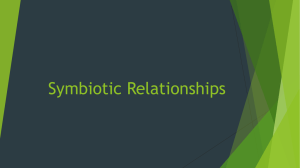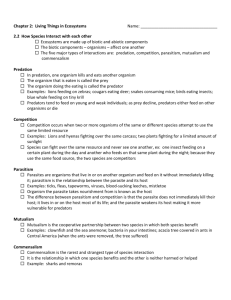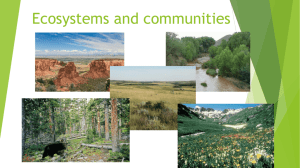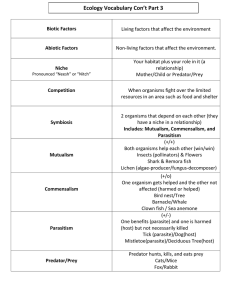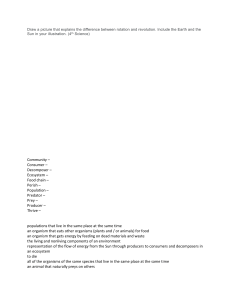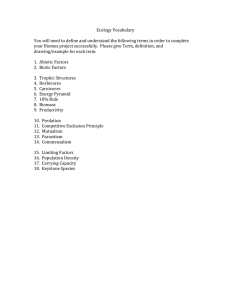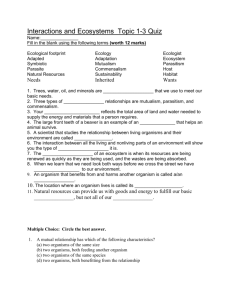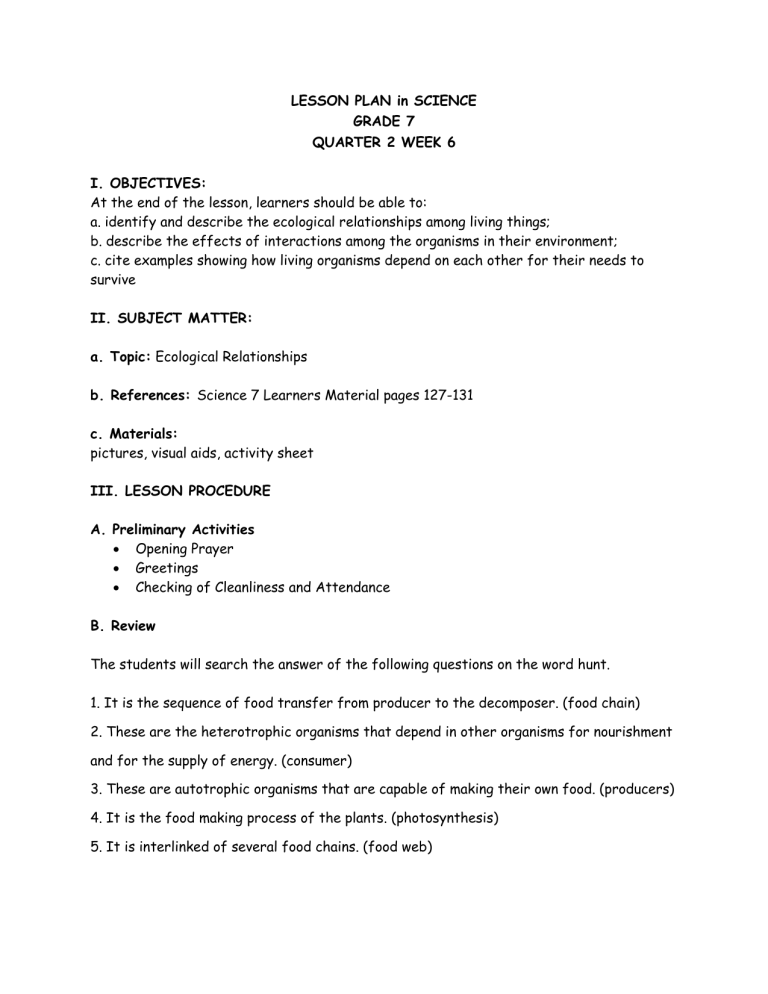
LESSON PLAN in SCIENCE GRADE 7 QUARTER 2 WEEK 6 I. OBJECTIVES: At the end of the lesson, learners should be able to: a. identify and describe the ecological relationships among living things; b. describe the effects of interactions among the organisms in their environment; c. cite examples showing how living organisms depend on each other for their needs to survive II. SUBJECT MATTER: a. Topic: Ecological Relationships b. References: Science 7 Learners Material pages 127-131 c. Materials: pictures, visual aids, activity sheet III. LESSON PROCEDURE A. Preliminary Activities Opening Prayer Greetings Checking of Cleanliness and Attendance B. Review The students will search the answer of the following questions on the word hunt. 1. It is the sequence of food transfer from producer to the decomposer. (food chain) 2. These are the heterotrophic organisms that depend in other organisms for nourishment and for the supply of energy. (consumer) 3. These are autotrophic organisms that are capable of making their own food. (producers) 4. It is the food making process of the plants. (photosynthesis) 5. It is interlinked of several food chains. (food web) C. Motivation Students will roam around the room to inspect the pictures (GALLERY WALK) Questions: 1. 2. 3. 4. 5. What pictures do you see around the room? What does these pictures depicts? Have you witnessed such situations? What relationships do the organisms have? How are the related to our lesson today? III. LESSON PROPER A. Activity Group the students into five(5). Each group will analyze the situation given in the picture. Then, answer the following questions. Group reporting will follow. B. Abstraction DISCUSSION/ANALYSIS Symbiotic Relationships – are interactions wherein two organisms of different species interact, with at least one of the species benefiting from the interaction while farming the organism or affecting at all. Mutualism– is the relationship where two organisms interact and benefit from each other. Parasitism– is a relationship where one organism is negatively affected and oftentimes harmed. Parasite – organism that benefits from the interaction Host– organism that is harmed in the interaction Commensalism– is a relationship where one organism benefits from the interaction without harming the other. Commensal – organism that benefits from the interaction Host – organism that is unharmed and provides help Competition - is a relationship in which organisms compete for the same needs such as food, shelter, or mate. Predation– is the interaction where the predator kills the prey for food. Predator–organism that kills for food Prey– organism that is being hunted C. Application Choose one (1) ecosystem below, write down 1 example per ecological relationship that can be found in the ecosystem you have chosen. D. Generalization 1. Why do living organisms need to interact with one another? 2. How do the interactions among organisms affect their lives and activities? 3. What will happen if there are no ecological relationships? 4. In your own opinion, do you think ecological relationship is important? Why or why not? IV. ASSESSMENT Multiple Choice. Read and answer the questions on the interaction of living things. Choose the letter of the correct answer and write your answer on the blank before the number. _____1. What ecological relationship exists when the banana plants are planted on the same area? a. commensalism b. competition c. predation _____2. A worm lives on the leaves of the calamansi plant. Which of the two organisms is the parasite? a. worm b. calamansi plant c. leaves _____3. Which of the following is an example of organisms that show commensalism? a. eagle and snake b. seedlings in a pot c. orchids on the branches of trees _____4. Which of the following organism is NOT a predator? a. eagle b. fly c. cat ______5. What ecological relationship exists between a lichen and a tree? a. parasitism b. predation c. commensalism V. ASSIGNMENT: 1. What are the ecological problems we experienced nowadays? 2. Give some conservation measures on improving the environment and preserving the natural resources in your area. Activity Read and analyze the given situation on each group. Then, answer the following questions. GROUP 1 The butterfly gets nectar from a flower, on the other hand, flower gets pollinated by the help of the butterfly. They benefit from one another. The relationship that exists between them is called mutualism. Questions : 1. With the given example, define mutualism. 2. Give another example of mutualism and describe relationship they have. Group 2 The egrets eat the insects around the cattle as it moves around. The egret gets benefited from the cattle yet the cattle is not affected at all. The egret is called commensal while the cattle is called host. The relationship that exists between them is called commensalism. Question: 1. What is commensalism? 2. What is the difference between commensal and host? 3. Give another example of commensalism. Group 3 The mosquito sucks blood from the human. The human is called host because it is the one that is harmed by the mosquito. On the other hand, mosquito is called parasite because it harms the host. The relationship that exists between them is parasitism. QUESTION: 1. What is the difference between parasite and host? 2. Given the situation above, give the definition of parasitism. 3. Give another example of parasitism. Group 4 The two deers compete for their basic necessities like food, shelter, or mate. The relationship that exists between them is called competition. QUESTION: 1. What is competition? 2. Why organisms need to compete with other organism? 3. Give other example of competition. Group 5 The tiger eats the deer. The tiger is called predator because it kills another organism for food. While the deer is called prey because it is killed and haunted by the predator. The relationship that exists between them is called predation. Questions: 1. What is predation? 2. What are the differences between predator and prey? 3. Give other examples of predation.
